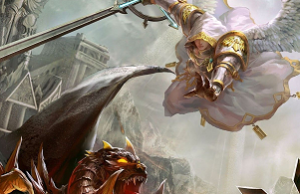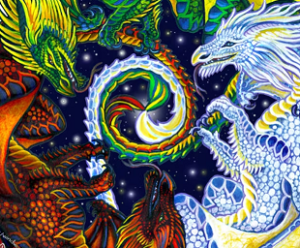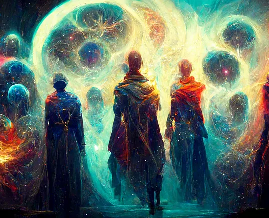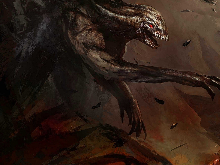Mythos: Difference between revisions
No edit summary |
No edit summary |
||
| Line 3: | Line 3: | ||
In the earliest of scripture, it is written that our existence came to be by the will of beings before time as we know it, beyond much of our understanding, appearing to men over the ages in visions of extraordinary beauty, fair-skinned with feathered white wings. Beacons of warmth and light that made man in their own image, then shared with them knowledge, and watched from beyond the veil as tribes progressed to civilizations through the ages. | In the earliest of scripture, it is written that our existence came to be by the will of beings before time as we know it, beyond much of our understanding, appearing to men over the ages in visions of extraordinary beauty, fair-skinned with feathered white wings. Beacons of warmth and light that made man in their own image, then shared with them knowledge, and watched from beyond the veil as tribes progressed to civilizations through the ages. | ||
These Angels, immortal embodiments of the Light, were once numerous in the ruined dimension of Atmos, where an eternal battle waged between them and creatures of malice, the Akuma, their direct opposites. Whether they physically fought or contended by other means is not known to us given their transcendent nature. The finality of this chapter came to be by when Kraus Eternia, one of seven Archangels, divine | These Angels, immortal embodiments of the Light, were once numerous in the ruined dimension of Atmos, where an eternal battle waged between them and creatures of malice, the Akuma, their direct opposites. Whether they physically fought or contended by other means is not known to us given their transcendent nature. The finality of this chapter came to be by when Kraus Eternia, one of seven Archangels, divine propagator of our world, led a rebellion and plotted an escape alongside three-hundred and two most trusted and gifted of his kind. This act destroyed the Creator and left him without a form, the the Angels alongside him would also not emerge some time after the formation of the cosmos. | ||
Thus the architect of the beginnings of Eternia came about through the actions of a heavenly host we know of through the act of self-sacrifice. This philosophy of selflessness is visible throughout the design of the cosmos, in the passage of the seasons, the generations of humanity, and the cycle observed in nature. It seems that, while the Creator's influence is indeed seen in all things, a distance is maintained and the course of the world is independent of the Angels beyond some key events. As this world is not their own. | Thus the architect of the beginnings of Eternia came about through the actions of a heavenly host we know of through the act of self-sacrifice. This philosophy of selflessness is visible throughout the design of the cosmos, in the passage of the seasons, the generations of humanity, and the cycle observed in nature. It seems that, while the Creator's influence is indeed seen in all things, a distance is maintained and the course of the world is independent of the Angels beyond some key events. As this world is not their own. | ||
Revision as of 03:58, 30 June 2023

Before Time: The Heavenly Host
In the earliest of scripture, it is written that our existence came to be by the will of beings before time as we know it, beyond much of our understanding, appearing to men over the ages in visions of extraordinary beauty, fair-skinned with feathered white wings. Beacons of warmth and light that made man in their own image, then shared with them knowledge, and watched from beyond the veil as tribes progressed to civilizations through the ages.
These Angels, immortal embodiments of the Light, were once numerous in the ruined dimension of Atmos, where an eternal battle waged between them and creatures of malice, the Akuma, their direct opposites. Whether they physically fought or contended by other means is not known to us given their transcendent nature. The finality of this chapter came to be by when Kraus Eternia, one of seven Archangels, divine propagator of our world, led a rebellion and plotted an escape alongside three-hundred and two most trusted and gifted of his kind. This act destroyed the Creator and left him without a form, the the Angels alongside him would also not emerge some time after the formation of the cosmos.
Thus the architect of the beginnings of Eternia came about through the actions of a heavenly host we know of through the act of self-sacrifice. This philosophy of selflessness is visible throughout the design of the cosmos, in the passage of the seasons, the generations of humanity, and the cycle observed in nature. It seems that, while the Creator's influence is indeed seen in all things, a distance is maintained and the course of the world is independent of the Angels beyond some key events. As this world is not their own.
The Making of Everything: The Divine Dragon's Dance of Color, and Discord

There was naught but an endless tide of white and the four slumbering Divine Dragons of brilliance. Of them there were four primary colors in red, green, blue, and grey, where once only the purest of white and black was known through the Angel and Akuma respectively. The Dragons were purposed in the world's creation to shape the cosmos and give substance to the plain canvas before them, from a formless, shallow space to what we know it as today in all of its grand complexity. They were granted powerful forms to carry out this task, made in the ideal of strength to wield the magic of creation to its fullest potential, appearing as armored, winged serpentine titans to mortals.
It was Aeldfyr that awoke first and exhaled warmth unto his siblings to rouse them from their comatose state. This breath formed the fȳr that shone as a beacon for ages to come, signalling the beginning of the day in the morning and the work ahead. Each of the Dragons then went about their role instinctively, giving an instructive roar through space and time to gain control over the building blocks of the universe in its infant stages. All at once the four danced together and flew in unison, weaving their divine spells as one sole force, a circle of cascading light in a spectrum not seen since. Opposing elements collided to form complex branches, giving rise to new forms of magic and color of all combinations. The fundamental laws of reality also came to be, and the first of the Primals. Spirits both great and small aiding in the creation of the world while the Dragons led them.
Fahldrex made the first celestial bodies and the planet itself.
Nyssa wove the flow the mana that would form the lifestream.
Saewylm conjured the rain giving clouds and established the first oceans.
Aeldfyr set the first star, the Sun, to grant warmth and light.
These grand tasks did not go unchallenged. An entity known of many names today, but the first was Baʽal, opposed the dance of the Divine. This malicious force was unaccounted for and managed to sew discord, bringing about the Primal of Despair, Hel, establishing adversity and contention even when matched with the near limitless might of the makers. The first to oppose them as the rhythm and flow of the world was unhindered up until that point.
The divine would forge the Moon to imprison this malevolent entity, as well as provide light during the night. The damage was already done, and the Primal that Baʽal summoned would escape into the world and take on its own identity, Moros. A creature of strife.
The Six Constants: Elder Gods of the Cosmos

During the formation of the vastness of everything, the Six Constants came to be as aspects of the fundamental laws of the unseen. Each residing over a fundamental aspect of the fabric of creation, and from them the many spirits descended. While the Divine Dragons and Beasts oversaw tangible creation, such as the elements, these Six are the manifestations of the unseen laws.
Amier resides over the vastness of space and appears as a giant humanoid figure of black midnight. Commonly referred to as Ymir (the Vdalion dialect) within Meranthe. This Primal split into ten Primordials during the war between the chaotic Primals and society, the pantheon, tipping the edge into humanity's favor.
Memoria is the personification of time. While no one truly knows the future, all that is and all there will be is contained within him.
Mortyl represents death, specifically of the living. Despite her domain, the nature of the Primal would not be considered evil, but rather a necessity.
Alacritas is life. A lady of beauty and grace, formed of silver. Along with Nyssa she woved the mana that flows through the world.
Pylae is hope. Golden wings not unlike an angel are always present. It was Pylae that managed to defeat Moros and cast him into the depths. Manifestations of Pylae have appeared throughout the ages as brief but magnificent flashes of empowering light.
Hel is the embodiment of despair and sin. When newly made, they took the shape of a terrifying armored giant and wreaked havoc across the world, under the name Lord Moros.
Helheim: Where The Light Doesn't Reach

When all was anew and the pantheon of Amier were still a millennia from establishing the Nine Realms, before man had arrived in Eternia, the world was a different place. There was no separation of the physical and spiritual, and that now Unseen were as tangible as you and I. As many kinds as there are animals and insects and fish today, made to be by the primals, from the Sun and its thousand orange tails that warm, fox-like spirits emerged from, to the rising moon that signalled the panther's nightly hunt was to begin. Life was fantastical and of a creative, almost random inspiration in these early days, where new colors, shapes and ideas were being discovered in the moment.
The most fearsome and despised of all the spirits also came to be, from outside of Creation. One of the Six original Primals, and the mightiest in strength. He took the name Moros and fashioned himself armor formed of the starless sky when Yggdrasil was still a sapling and had yet to bear its golden fruit. Not satisfied with the pure black lustre of the metal alone, the primal learned the art of jewelsmithing and decorated the breast and helm with enchanted gemstones. When Sakeanis the Wolf of Winter set in motion a terrible cold, Moros slew many of the beast's children in search of the most lustrous fur, but it was vanity rather than necessity that drove the actions of the primal.
These carnal sins led to contention with most, driven by conquest and domination. Earning the ire of many on the singular, crude continent of the time, the Primal soon became known as 'The Dark Lord'. As easily as opposition formed, Moros also gained followers that were seduced by his power and charisma, transforming once peaceful Primals into natural disasters of his making. The amassing of his armies also led to the construction of great fortresses through the ages, such as Drunfel, Arinth, and Sitrinhar, built in the marred place we know simply as the 'shadow lands' today.
The Generals of the Dark Lord were dubbed his Marquis, a godhand of never more than five that carried out the will of their master. Among the originals were Oneiros the Master of Fate, Felfyraxes the Black Dragon, and Mori the Deep One. The greed and pride that dominates the hearts of most Dragons can be traced back to the influence of Felyraxes, a Dragon that could contend with even the divine four, though how he came to be is not known. The Deep One was an eldritch ally discovered in the far distant corners of the Void, the bleakest ocean.
Nothing could quite prepare the Dark Lord for the arrival of man, however. As they were more susceptible to temptation than the spirits but also far more dangerous. The most promising of those that served him would become the Nethradin in death, and over time, the Marquis became a cultist symbol as it was entirely formed of ascended 'humans' that had made it as the Generals of Helheim.
Netherworld: The Spirit Realms:
(unfinished)
Aspects that came to be when Amier split into ten during the divine wars Left to put order into the Netherworld as Helheim was threatening all, and founded Vanaheim etc enarr, gala, nemea, athelios, aschea, vdali, chireus, ualdir, mestra, caius